This document describes the purpose of applying preservatives to various wood products. A description of wood preservatives registered for use in Florida is also provided.
Wood is well-suited as a structural material because it is very strong for its weight and can be easily cut into the needed dimensions. It is available in a range of species that can suit a variety of demands, such as utility poles, fence posts, marine pilings, lumber, timbers, and plywood. These wood products are used in widely different environments, ranging from above ground, to ground contact, to both freshwater and marine settings. Wood is highly durable if properly protected from pests and excessive moisture (Figure 1).
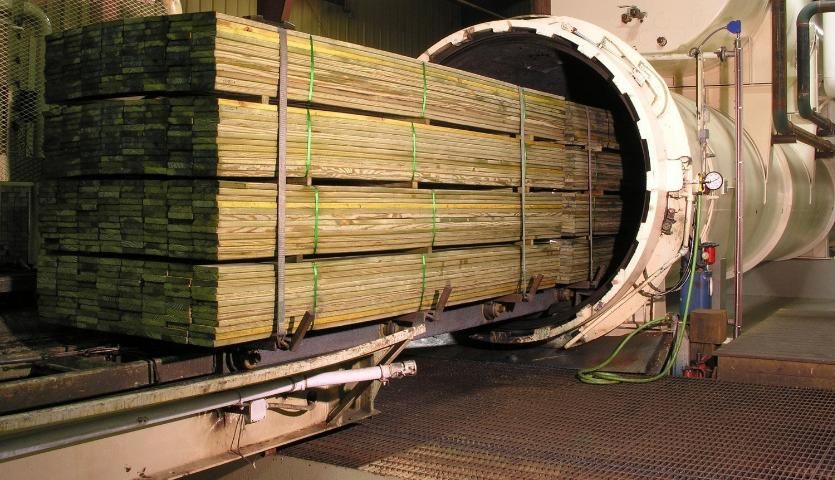
Credit: BB&S Treated Lumber of New England, North Kingstown, RI
Effective wood preservation treatments protect wood products from pests and extend the service life of those products. This has two important benefits: environmental and economic.
Wood is the only renewable building material. It comes from trees growing in forests, which serve environmental and recreational purposes; it is important to conserve and protect this valuable resource. By extending the service life of wood products, wood preservation reduces the frequency with which those products need to be replaced. This helps preserve forests.
Replacing wood products in service can be an involved and expensive endeavor. As an example, consider what is required to replace utility poles. To make new poles, you must harvest trees, cut them to the proper dimension, peel and dry them, and treat them with preservatives. Then you must remove the old poles, which could temporarily interrupt communications and electric service for many people. Finally, you must put the newly produced poles in place. Each of these steps, and the many others not mentioned, cost money, not including any costs resulting from the failure of the original poles (e.g., downed power lines when a pole falls). Reducing the frequency of replacement makes wood products more economical and saves money (and trouble) for people who rely on them.
Insects, fungi, and bacteria can damage wood over time. Treating wood with pesticides can prevent wood from rotting as quickly. Several wood preservatives are registered with the United States Environmental Protection Agency (EPA) and the Florida Department of Agriculture and Consumer Services (FDACS), each with different uses and potential risks.
Wood can be a source of food and/or shelter for many microorganisms and small animals, but those which damage the wood are considered pests. If pests gain access to susceptible wood, they can break down and/or consume its structural components and reduce its service life. Wood products that meet the ground are generally at greater risk of being attacked by different pests. Since all pests require adequate moisture, products placed in the ground or in direct contact with water are at higher risk of attack from pests.
Wood Pests
Fungi
Fungi are spore-producing organisms that derive metabolic nourishment from living or dead host tissue. There are three general classes of fungi that attack wood; these include decay, stain, and mold fungi. However, each requires adequate moisture and temperature to attack wood.
The first type, decay fungi, feed on various components of wood and can extend deep into the product. The fungi feed by using enzymes to break down the lignin and other hard fibers. This results in the long and hard wood fibers becoming spongy and weak. This structurally weaker product will often need to be replaced. Again, wood that is in contact with the ground or water is most susceptible to attack by decay fungi.
Stain and mold fungi do not reduce wood's structural integrity, but rather reduce the value of wood and the effectiveness of wood preservation. They also increase the permeability of wood; water penetrates the wood more easily, making conditions more favorable to decay fungi that can reduce the service life of the wood product. This process usually starts after insect infestation, such as wood-boring beetles (Figure 2).
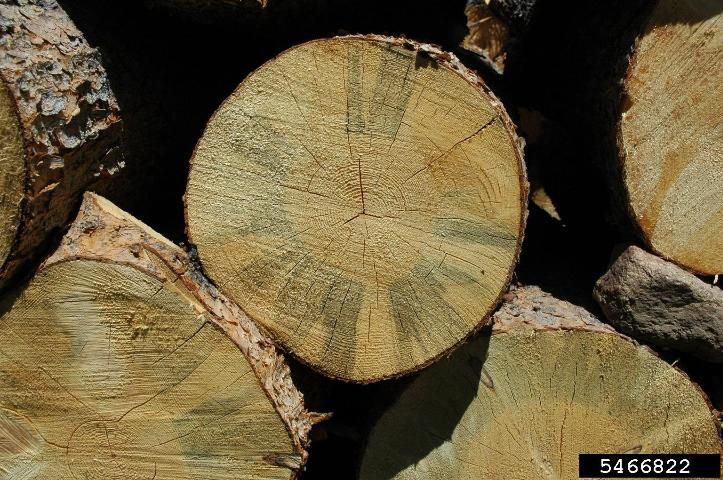
Credit: William M. Ciesla, Forest Health Management International, bugwood.org
Insects
Insect pests include termites, wood-boring beetles, carpenter ants (Figure 3), and carpenter bees. Some of these insects eat wood while others only use it for shelter (Figure 4). All, however, destroy wood in the process and, like decay fungi, can weaken the wood and cause it to fail. Subterranean termites and carpenter ants are more likely to attack wood that is in ground contact because they prefer wet or moist wood that does not dry readily, though wood above ground level is not immune.
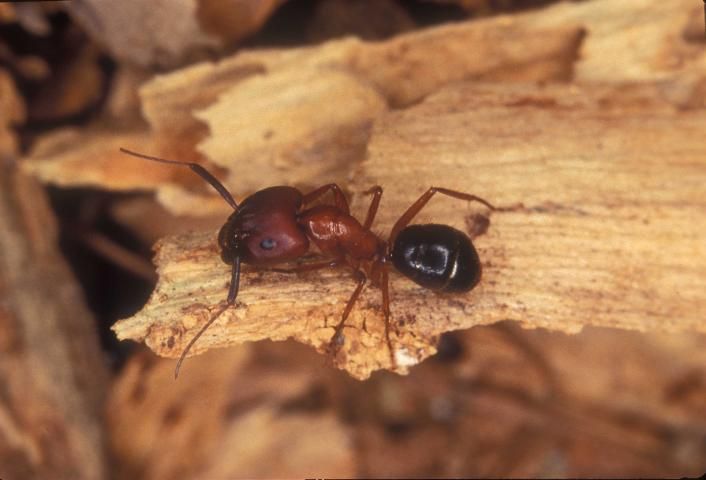
Credit: UF/IFAS Entomology and Nematology
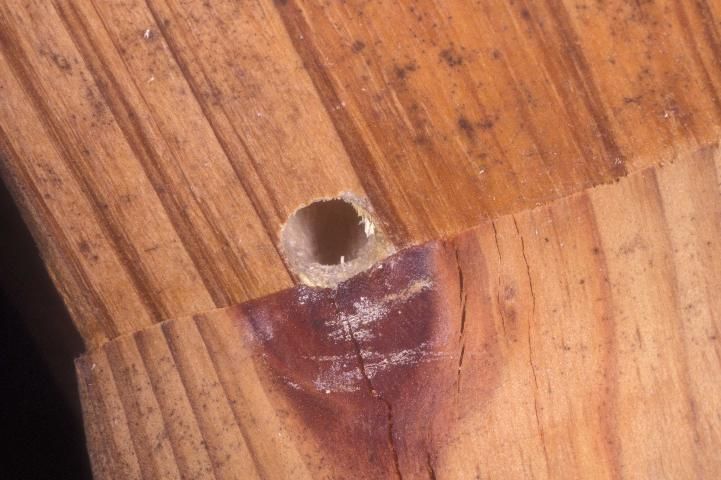
Credit: UF/IFAS Entomology and Nematology
As their name implies, marine borers will attack wood, such as pilings, that is submerged in salt water or brackish waters. Some bore deeply into wood and greatly reduce its structural strength. Other species make more shallow tunnels, which can make the surface of the wood susceptible to erosion from wave action.
Preservation
Wood preservation is the treatment of wood products with chemicals to protect the wood from pests; therefore, these chemicals are considered pesticides. To be effective, a treatment must be thorough enough so that no untreated wood is exposed and available for pests to attack. The EPA classifies wood products that have been treated with preservatives as "treated articles" rather than as pesticides; treated wood is therefore not regulated under the Federal Insecticide, Fungicide and Rodenticide Act (FIFRA), though its uses may be restricted by state law and/or the preservative label. Also, handling freshly treated wood may pose some health risks.
The chemicals used are classified as pesticides and are referred to as wood preservatives. They are generally classified as either oilborne preservatives or waterborne preservatives based on whether the product is formulated in either oil or water. A description of those registered for use in Florida is presented in Table 1 where a summary of their properties is also provided. Wood preservatives are subject to federal and state pesticide regulations.
Oilborne Wood Preservations
Oilborne wood preservatives are formulated or mixed with solvents such as petroleum oils and mineral spirits; they are largely used where human contact with the treated wood will be rare. The solvent can affect characteristics of the treated wood such as color, cleanliness (oily to the touch), paint-ability, and odor. Preservative solutions with heavy, less-volatile oils adversely affect these traits more than solutions with more-volatile, lighter oils or solvents. However, lighter solvents might provide less protection in some situations, so all aspects of the wood's end use should be considered. Oil-based solvents are also flammable and can pose health risks. Treatment with oilborne preservatives does not make wood swell. The solvents make treated wood less susceptible to cracks and separation along the grain of the wood.
Copper Naphthenate
Copper naphthenate is a thick, dark-green liquid that can be dissolved in heavy or light oils, though formulations that are emulsifiable in water are also available. Use of lighter oils aids penetration into hard-to-treat species.
Copper naphthenate protects against wood-destroying fungi and insects, though less so against termites. Treated wood can be used for above-ground, ground contact, and freshwater sites. Treated softwoods are commonly used for utility poles, greenhouse lumber, seedling trays, posts, piers, and docks. Railroad ties commonly utilize hardwoods treated with copper naphthenate.
Copper naphthenate can cause skin and eye irritation, and prolonged skin contact may cause allergic reactions. Wood treated with copper naphthenate has a strong odor and is unsuitable for contact with food or for use in food gardens. However, the preservative can be used around bedding plants after the volatile solvent evaporates.
Oxine Copper
Oxine copper (copper-8-quinolinolate or "Copper 8") is a greenish brown solution that contains the metals copper and nickel in equal amounts. It can be dissolved in a range of organic solvents, but protection is best when heavy oils are used. Treated wood is odorless and is paintable.
Oxine copper is toxic to wood-destroying fungi and insects and is effective above ground but not when in contact with the ground. Exterior, above-ground uses include playground equipment and decking. Oxine copper is permitted for use in wood that comes in direct contact with food, such as flooring in meat lockers, food pallets, and crates.
Oxine copper also comes in a water-soluble formulation. In that form, it is corrosive and can cause irreversible eye damage.
Pentachlorophenol
Pentachlorophenol, or "penta," is a crystalline, odorless solid that can be dissolved in light or heavy petroleum oil. The desired end use of the wood will influence the choice of solvent. The solvent used affects the odor and color of the solution (nearly colorless to dark brown), the appearance, cleanliness, weight, and paint-ability of the treated wood, and how the wood can be used. For example, while heavier solvents cause more problems with paint-ability, color, and cleanliness of the treated wood and make it up to 20% to 50% heavier, they allow the wood to be used in harsher environments, such as for ground contact.
Penta resists leaching because it is relatively insoluble in water. It protects against decay fungi and insects in wood used above ground, in ground contact, and in freshwater.
Penta is most commonly used to treat utility poles and crossarms. Wood treated with penta is not for residential use, nor is it suitable for use in living areas or where contact with plants, animals, or food is likely.
Penta is a restricted-use pesticide because of concerns that it can cause tumors, birth defects, and cancer. EPA considers it to be a probable human carcinogen. Because of the concern over birth defects, pregnant women should avoid all direct exposure to penta. Vapors irritate the eyes and respiratory tract. Contact with penta may cause skin disorders or irritation. Inhalation of concentrated vapors or excessive skin contact with penta may cause fever, headache, weakness, dizziness, nausea, loss of coordination, sweating, convulsions, and low body temperature; prolonged exposure could damage the liver, kidneys, and nervous system. Some formulations may be fatal if inhaled or absorbed through the skin.
Penta is also toxic to plants, fish, and wildlife. Penta is a marine pollutant and is not approved for use in wood products that would be used in marine environments.
Water Preservatives
Waterborne preservatives can be dissolved or suspended in water, though they may have other chemicals added (e.g., ammonia, surfactant) to aid in penetration. Most remain fixed in the wood (i.e., resistant to leaching) after treatment.
Examples of treated commodities include timber, posts, building foundations, poles, and piling. Waterborne preservatives are especially suited for lumber because when dry, the treated wood is clean to handle, odorless, and paintable.
Alkaline copper quaternary (ACQ) compounds
ACQ wood preservatives (types A, B, C, and D) are composed of copper oxide and a quaternary ammonia compound. The ammonia carrier improves the penetration of ACQ Type B into hard-to-treat species. Type D has an amine carrier and is used for easier-to-treat woods, such as southern yellow pine. Type C uses both carriers. The absence of chemicals like arsenic or chromium has made ACQ one of the most widely used residential wood preservatives.
ACQ can be used on many softwood species, and the range of formulations provide flexibility in treating different species for different uses, both aboveground and in-ground contact. The color of treated wood varies with the chemical type, from dark greenish-brown fading to a lighter brown, with Type B to lighter greenish-brown with Type D. The color of wood treated with Type C varies between Types B and D depending on the formulation.
ACQ concentrate is corrosive and can cause skin burns and irreversible eye damage. Prolonged or frequently repeated skin contact with the amine formulation may cause allergic reactions.
Copper azoles
Copper azoles contain copper, along with fungicides from a family of chemicals known as the triazoles; together, they protect wood from insects and decay fungi. The two types of copper azole are called dissolved and micronized, sometimes referred to as "dispersed," which refer to how the copper is present in the preservative. In the dissolved type, the copper metal is liquefied into a solution using a chemical. In micronized copper azoles, tiny particles of copper are suspended in water.
Copper azoles protect softwoods from wood-destroying fungi and insects. Cooper azoles have largely replaced chromated copper arsenate (CCA) as the preservative of choice for retail sale of lumber for residential uses.
Copper azoles are corrosive and can cause skin burns and irreversible eye damage.
Tebuconazole and propiconazole
Tebuconazole and propiconazole are triazole fungicides. In addition to being components of copper azole products, tebuconazole and propiconazole can form a stand-alone product which could be mixed with other wood-preserving chemicals such as quaternary ammonium compounds. The fungicides are also formulated with the insecticide imidacloprid for spray, dip, or pressure treatment to protect wood from wood-destroying fungi and insects; treated products include window and door trim, fascia boards, and millwork.
The exposure concerns will vary by product, with some being corrosive and able to cause irreversible eye damage.
Borates
Borate wood preservatives have been used to treat wood for interior construction including joists, sheathing, sill plates, and other uses for over 70 years. Borates leach readily from treated wood; therefore, the treated wood is suited for use only above ground and where it can be protected from wetting. The high solubility aids penetration during treatment, as borates "follow the water" into the wood's interior. Borates add no color to treated wood and so do not interfere with staining.
Borates provide excellent protection against wood-destroying fungi and insects, including termites, wood-boring beetles, and carpenter ants. Pressure treatment of various softwoods for framing lumber in areas with high termite hazard and for cabin logs is common. In the latter case, the wood must be stained to prevent the preservative from leaching out when the logs are exposed to rain.
Borates can cause mild eye irritation but have low toxicity to fish, birds, and mammals.
Is treated wood safe for raised bed gardening?
The EPA determines product safety during their wood preservative registration process. The wood preservatives used in treated wood available to consumers have been registered by the EPA for general use, which means that the EPA has determined it is relatively safe for most, if not all, consumer applications. Different people perceive safety in different ways. If you're concerned, you could always apply some type of coating or sealer to reduce the amount of soil contact with the preservative-treated wood, or perhaps even put a sheet of plastic between the treated wood and the soil if you want to minimize or eliminate contact between wood and soil. Please note that most of the treated wood that's two inches or less in thickness tends to be treated for above-ground uses, so it may not last very long in a ground-contact application. Be sure to contact the manufacturer of the treated wood product or the manufacturer of the wood preservative chemical for information on product safety. There should be contact information on the end tag of the treated wood at your lumber retailer (Figure 5).
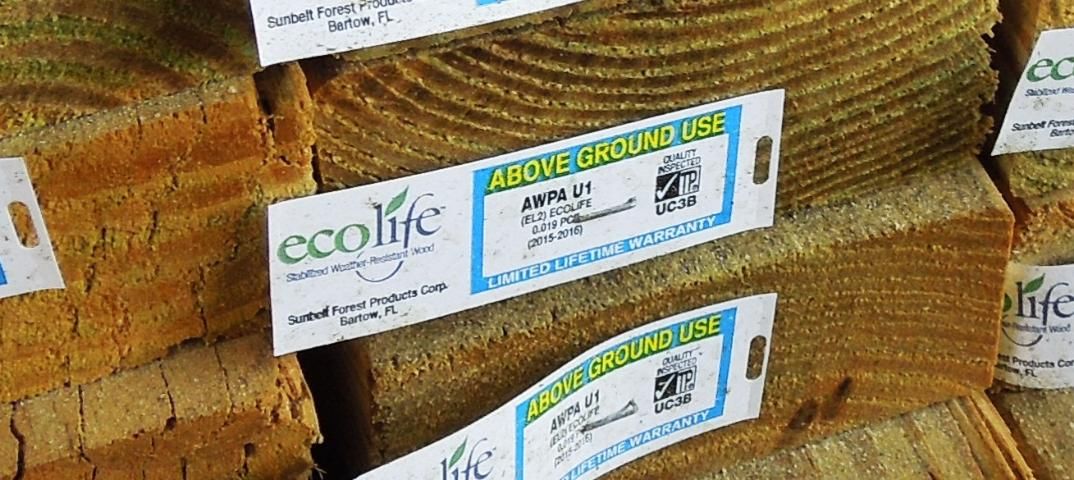
Credit: UF/IFAS Pesticide Information Office